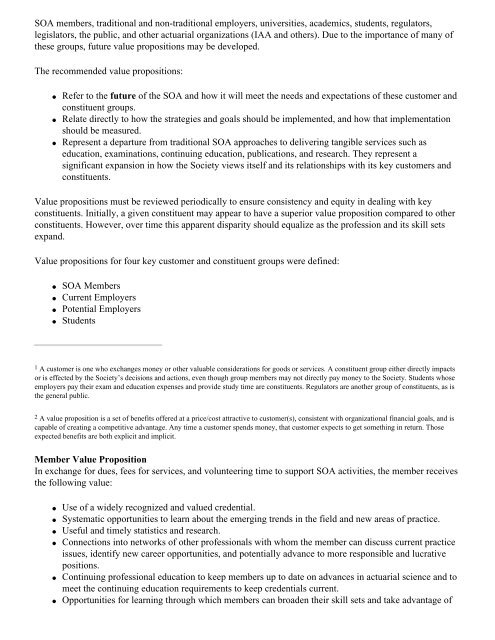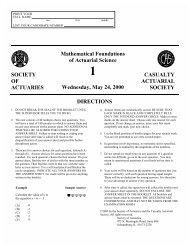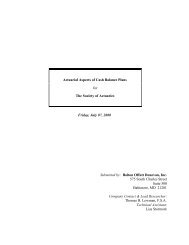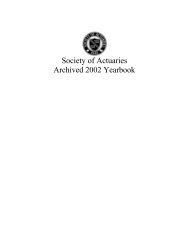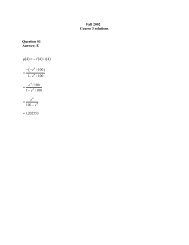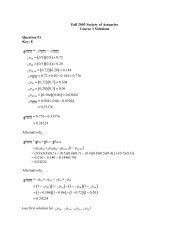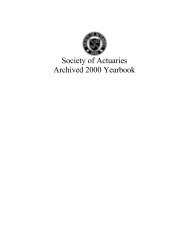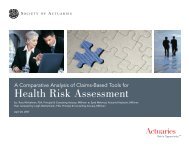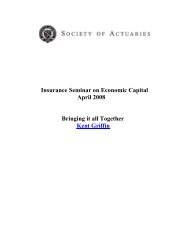- Page 1 and 2:
2003 Archived Yearbook
- Page 3 and 4:
Course 2 Interest Theory, Economics
- Page 5 and 6:
Requests for application forms or o
- Page 7 and 8:
Israel - Alan Dubin, FSA dubin@netv
- Page 9 and 10:
Edward L. Robbins Vice-President Sh
- Page 11 and 12:
Kathleen R. Wong Dale H. Yamamoto G
- Page 13 and 14:
SECTION 1. Place and Time. The annu
- Page 15 and 16:
Board. Members of the Board of Gove
- Page 17 and 18:
Board of Governors. The President o
- Page 19 and 20:
Treasurer shall strike the name of
- Page 21 and 22:
een received. Such notice shall adv
- Page 23 and 24:
On October 15, 2000, the SOA Board
- Page 25 and 26:
delegated by such an organization.
- Page 27 and 28:
should indicate the extent to which
- Page 29 and 30:
Principal would be served by the Ac
- Page 31 and 32:
MEMORANDUM TO: The Members of the A
- Page 33 and 34:
With respect to the definitions, a
- Page 35 and 36:
commenters questioned how an actuar
- Page 37 and 38:
HOME | SITE MAP | EMAIL WEBMASTER
- Page 39 and 40:
Course 7 Examination Committee Cour
- Page 41 and 42:
Committee on Life Insurance Company
- Page 43 and 44:
Ronald Gebhardtsbauer 2004 Larry M.
- Page 45 and 46:
Audit Committee 2002 - 2003 This Co
- Page 47 and 48:
Committee on Discipline 2002 - 2003
- Page 49 and 50:
Committee on Strategic Planning 200
- Page 51 and 52:
Gail M. Ross President Mary Frances
- Page 53 and 54:
The Implementation Task Force on Se
- Page 55 and 56:
Operations Committee 2002 - 2003 Th
- Page 57 and 58:
Examination and Basic Education Com
- Page 59 and 60:
Board Advisory Group on Education a
- Page 61 and 62:
Professionalism Education Managemen
- Page 63 and 64:
Staff Liaisons: Marta L. Holmberg,
- Page 65 and 66:
Course 2 Examination Committee 2002
- Page 67 and 68:
Course 4 Examination Committee 2002
- Page 69 and 70:
EA-2 (Segment A) Examination Commit
- Page 71 and 72:
Course 5 Education Objectives Commi
- Page 73 and 74:
Sharon Giffen Luce Giroux R. Dale H
- Page 75 and 76:
Course 6 Education Objectives Commi
- Page 77 and 78:
Jonathan W. Porter Leonard J. Rebac
- Page 79 and 80:
Advisory Group Christopher M. Bone
- Page 81 and 82:
Course 8-Finance and Course 8-Inves
- Page 83 and 84:
Course 8-Investments Examination Co
- Page 85 and 86:
Course 8 - Health, Group Life and M
- Page 87 and 88:
Course 8-Individual Insurance Educa
- Page 89 and 90:
Janet W. Reinke John W. Robinson Di
- Page 91 and 92:
Actuarial Promotion Committees 2002
- Page 93 and 94:
Task Force on Academic Infrastructu
- Page 95 and 96:
Joint CAS/SOA Committee on Career E
- Page 97 and 98:
Back to Actuarial Promotion Committ
- Page 99 and 100:
Board Advisory Group on Publication
- Page 101 and 102:
Editorial Board - The Actuary 2002
- Page 103 and 104:
Honorary Advisory Board: Patrick L.
- Page 105 and 106:
Daniel A. Nitz Peter Lynn Perkins C
- Page 107 and 108:
Editorial Board - Monograph Series
- Page 109 and 110:
Board Advisory Group on Continuing
- Page 111 and 112:
Back to Committees & Task Forces
- Page 113 and 114:
Meetings and Seminars Staff Liaison
- Page 115 and 116:
Board Advisory Group on Research 20
- Page 117 and 118:
Committee on Knowledge Extension Re
- Page 119 and 120:
Joint CAS, SOA Committee on Actuari
- Page 121 and 122:
Admissions Committee 2002 - 2003 Th
- Page 123 and 124:
Finance Practice Area Committees 20
- Page 125 and 126:
Task Force on the Personal Actuary
- Page 127 and 128:
Committee on Finance Research 2002
- Page 129 and 130:
Finance Practice Area Professional
- Page 131 and 132:
Committee on the Dynamic Financial
- Page 133 and 134:
Back to Finance Practice Area Commi
- Page 135 and 136:
Committee on Health Benefit Systems
- Page 137 and 138:
Healthcare System in Crisis Task Fo
- Page 139 and 140:
Joint SOA/HIAA Disability Chartbook
- Page 141 and 142:
Committee on Health Benefit Systems
- Page 143 and 144:
Group Life Insurance Experience Com
- Page 145 and 146:
Long-Term-Care Experience Committee
- Page 147 and 148:
Medical Large Claims Experience Com
- Page 149 and 150:
Committee on Post Retirement Welfar
- Page 151 and 152:
Committee on Health Professional De
- Page 153 and 154:
Life Practice Advancement Committee
- Page 155 and 156:
Committee on Life Insurance Mortali
- Page 157 and 158:
Back to Life Insurance Practice Are
- Page 159 and 160:
Individual Life Insurance Experienc
- Page 161 and 162:
Mortality and Morbidity Liaison Com
- Page 163 and 164:
Task Force on Mortality Guarantees
- Page 165 and 166:
Committee on Life Insurance Special
- Page 167 and 168:
Retirement Systems Practice Area Co
- Page 169 and 170:
Committee on Retirement Systems Res
- Page 171 and 172:
Retirement Plans Experience Committ
- Page 173 and 174:
Committee on Retirement Systems Pro
- Page 175 and 176:
Committee on Post Retirement Needs
- Page 177 and 178:
Joint Academy/Society of Actuaries
- Page 179 and 180:
Board Advisory Group on Internation
- Page 181 and 182:
China Region Committee Southeast As
- Page 183 and 184:
Sherry Lu, FSA, FCIA 1998 Education
- Page 185 and 186:
Robert Fok Tak-Pun, FSA 1985, FCIA
- Page 187 and 188:
Southeast Asia Committee (SEAC) Mem
- Page 189 and 190:
Martha Sikaras Manager of Global In
- Page 191 and 192:
China Region Committee Meeting Minu
- Page 193 and 194:
Latin America Committee 2002 - 2003
- Page 195 and 196:
Actuarial Education and Research Fu
- Page 197 and 198:
2003 Conflict of Interest Policy fo
- Page 199 and 200:
equirements: (I) The applicant shal
- Page 201 and 202:
The term of three of the Vice-Presi
- Page 203 and 204:
PUBLIC EXPRESSION OF PROFESSIONAL O
- Page 205 and 206:
DENMARK: Danish Actuarial Associati
- Page 207 and 208:
Phone: 81-3-5219-2384 Email: yuji-o
- Page 209 and 210:
2003 Yearbook Deceased Members Hype
- Page 211 and 212:
ASA 1963 ASA 1995 ASA 1983 FSA 1993
- Page 213 and 214:
FSA 1961 ASA 1948 ASA 1969 FSA 1978
- Page 215 and 216:
ASA 1952 ASA 1958 FSA 1958 FSA 1963
- Page 217 and 218:
In Memory of J. Ross Hanson, FSA J.
- Page 219 and 220:
In Memory of Robert M. Katz, ASA Ro
- Page 221 and 222:
In Memory of Charles W. McMahon Apr
- Page 223 and 224:
In Memory of W. Tris Stevens March
- Page 225 and 226:
In Memory of David P. Hayes Septemb
- Page 227 and 228:
to their fullest. Even more importa
- Page 229 and 230:
In Memory of Alfred W. Perkins, ASA
- Page 231 and 232:
2003 DUES The schedule of dues (U.S
- Page 233 and 234:
● Current year’s dues will be d
- Page 235 and 236:
475 N. MARTINGALE RD., SUITE 800, S
- Page 237 and 238:
practice and to give advice on a sp
- Page 239 and 240:
through difficult times; its reputa
- Page 241 and 242:
individual and group. Despite heavi
- Page 243 and 244:
The long-term trend in the general
- Page 245 and 246:
2003 Yearbook Membership Statistics
- Page 247 and 248:
2003 Yearbook Analysis of Membershi
- Page 249 and 250:
2003 Yearbook Schedule of Membershi
- Page 251 and 252:
Vietnam Zimbabwe 4 0 0 2 213 0 1 4
- Page 253 and 254:
2003 Yearbook Society of Actuaries
- Page 255 and 256:
For the Profession ● ● ● ●
- Page 257 and 258:
2. Teachers Pension Plan Mortality
- Page 259 and 260:
Douglas C. Doll Stephen G. Kellison
- Page 261 and 262: Harry H. Panjer James F. Reiskytl J
- Page 263 and 264: Linda B. Emory Gary Corbett Anna M.
- Page 265 and 266: Julius Vogel Ian M. Rolland Secreta
- Page 267 and 268: Secretary Fredrick E. Rathgeber Her
- Page 269 and 270: Treasurer Walter L. Grace Editor Al
- Page 271 and 272: Editor John R. Larus Alden T. Bunya
- Page 273 and 274: advice, "When you come to the fork
- Page 275 and 276: There must be a lot of inventing in
- Page 277 and 278: The questions that emerged were, "W
- Page 279 and 280: The Annual Prize The Triennial Priz
- Page 281 and 282: July 1, 1991 - June 30, 1992 Robert
- Page 283 and 284: 1988-1991 A. Stephen Beach "Statuto
- Page 285 and 286: 1999 Uwe Schmock "Estimating the Va
- Page 287 and 288: and C.D. Daykin, G.D. Bernstein, S.
- Page 289 and 290: 1999 (No Award) 1998 (No Award) 199
- Page 291 and 292: 1997 (No Award) 1996 (No Award) 199
- Page 293 and 294: 1995 Gary Parker, Ph.D., A.S.A. "St
- Page 295 and 296: 1995 - 1997 Andrew Ang and Michael
- Page 297 and 298: career/guidance counselors and educ
- Page 299 and 300: BeAnActuary.org), developed jointly
- Page 301 and 302: Kara L. Clark, F.S.A. Staff Fellow
- Page 303 and 304: Lois Chinnock Section & Election Co
- Page 305 and 306: Society of Actuaries Strategic Plan
- Page 307 and 308: can grow while continuing to provid
- Page 309 and 310: profession must also aggressively i
- Page 311: ● ● ● ● ● ● ● ● ●
- Page 315 and 316: Strategies High-level planned appro
- Page 317 and 318: Supporting Goals: 4.1 Marketing pla
- Page 319 and 320: Supporting Goals: 9.1 Members repor
- Page 321 and 322: 12.5 Information provided supports
- Page 323 and 324: (1) The President and the President
- Page 325 and 326: (6) Each Participating Organization
- Page 327 and 328: (13) Each Participating Organizatio
- Page 329 and 330: Membership Communications (22) In o


